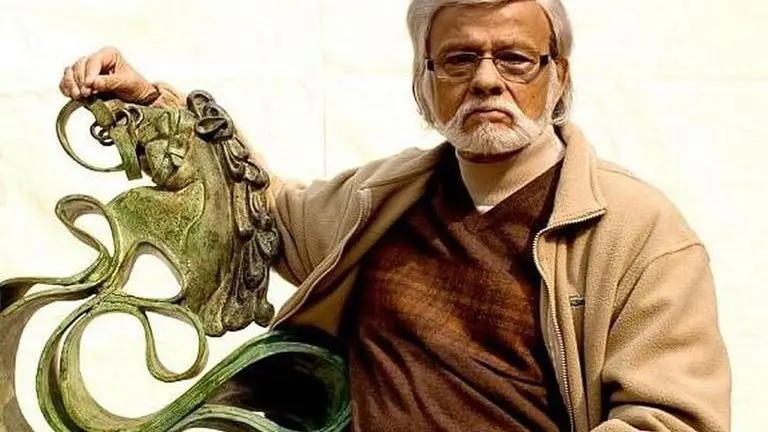Updated 27 March 2020 at 21:26 IST
Satish Gujral: A man of many experiences, solid resilience, and a sense of humour
Notwithstanding his age, Gujral would insist on immersing himself in his shows and "live it to the fullest", like he lived his life.
- World News
- 5 min read

Even while working on his last major retrospective that marked his 90th birthday, artist Satish Gujral was full of seemingly inexhaustible energy, recalls Pramod Kumar KG who had curated the show.
Notwithstanding his age, Gujral would insist on immersing himself in his shows and "live it to the fullest", like he lived his life.
"One thing I will always remember about him is his zest to constantly push his exhibitions to their outermost limits," Kumar said.
A look at Gujral's eventful life, that came to an end on Thursday night, reveals that it was essentially divided into compartments of experiences experiences of horror, trauma and suffering, of falling in love, of not being able to hear for over six decades and getting the world of sound back and then losing it voluntarily, of visiting a foreign land and finding resonance -- all of which very generously spilled over to his canvases, making him the artist that he was and will always remain.
Gujral was born in 1925 in Jhelum in pre-partition west Punjab, so he was only a teenage boy when he witnessed people being massacred in front of his eyes during the Partition riots.
Advertisement
His older brother and former Indian Prime Minister I K Gujral in his autobiography said the artist had to take "shelter and succour" at a friend's house in Lahore during the riots. It is no surprise that the violence left a long lasting impression on his young mind.
After moving to India, he painted for nearly half a decade, till the mid 1950s, on just the Partition -- exhausting all his memories and never revisited the theme again.
Advertisement
"I don't think there is any better artist chronicler of partition than Satish Gujral. This first hand experience gave him a unique perspective," Kumar said.
Getting over the trauma of witnessing a wave of riots was one thing, but the author inspires nothing but awe when one realises the magnitude of the artistic legacy Gujral created despite being hearing impaired, because of a childhood illness, for most of his life.
He pursued art first from the Mayo School of Art in Lahore and then from the J J School of Art in Bombay to create a name for himself.
By the end of his life, there wasn't creative medium left for him to explore. He had done it all painting, sculpture, graphics, architecture, murals and more.
The silence over the years had probably given him too much, because when he regained his sense of hearing at the age of 72, he voluntarily removed the ear implant six years later.
Among some of his less harrowing life altering experiences would be his trip to Mexico on a scholarship.
He studied at the revered Palacio de Bellas Artes in Mexico City, where he apprenticed under renowned artists Diego Rivera and David Alfaro Siqueiros - who were remarkable figures of the 20th-century art scene. Gujral deeply identified with Riviera's works on human suffering.
He went on to win the da Vinci Award for lifetime achievement from Mexico. At home, he has been awarded the Padma Vibhushan, the second highest civilian award in India, and the Lalit Kala Akademi award.
Once back to India, Gujral fell in love and married his wife Kiran, an experience that critics say brought a visible change in his works.
"The pain within softened. The silence within turned golden. The blacks, the stark reds, the searing whites turned to warmer shades, the lines did not feel as if they would explode out of the canvas in despair," late writer Uma Vasudev had written about the artist.
The couple raised a son (Mohit) and two daughters (Alpana and Raseel) together.
Interestingly, Gujral's career coincided with those of the members of the Progressive Artists' Group -- M F Husain, S H Raza, F N Souza, K H Ara among others -- who, at the time, had taken the art world by storm with their artistic practices inspired from the West.
His version of modernism, however, stood out because of his distinct style that was rooted not just in his own experiences but also in Indian traditions.
In 1968 Gujral abandoned his career as a painter and took up architecture only to return to his first love nearly two decades later. He had said got "bored" of architecture.
Though he had no training in the field of architecture, during that phase he designed several structures across the globe including the Belgian Embassy in Delhi, summer palace in Riyadh, Saudi Arabia, the CMC (Computer Maintenance Corporation Pvt. Ltd) research centre in Hyderabad, and the Goa University, only to show the creative prowess he harboured.
Gujral also managed to develop a sense of humour, and appreciation for his fellow artists came to him naturally.
Arun Vadehra, founder of the Delhi-based Vadehra gallery called the artist a "visionary".
He said the artist used to be a neighbour living bang opposite his gallery in Defence Colony.
"He was just five minutes away. I used to frequent him quite often. I remember he had a great sense of humour. Often he would come up with certain quotes or jokes. He was very supportive of his fellow artists. He was one of those artists who admired his fellow artists rather than have any envy," the gallerist said.
Published By : Press Trust Of India
Published On: 27 March 2020 at 21:26 IST
